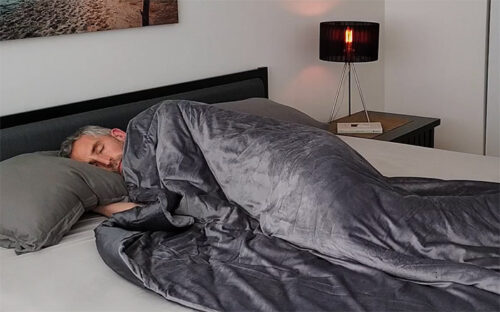Disclosure: This website is supported by my readers. If you choose to buy a product after clicking a link, I may receive a commission, at no extra cost to you. Learn more.
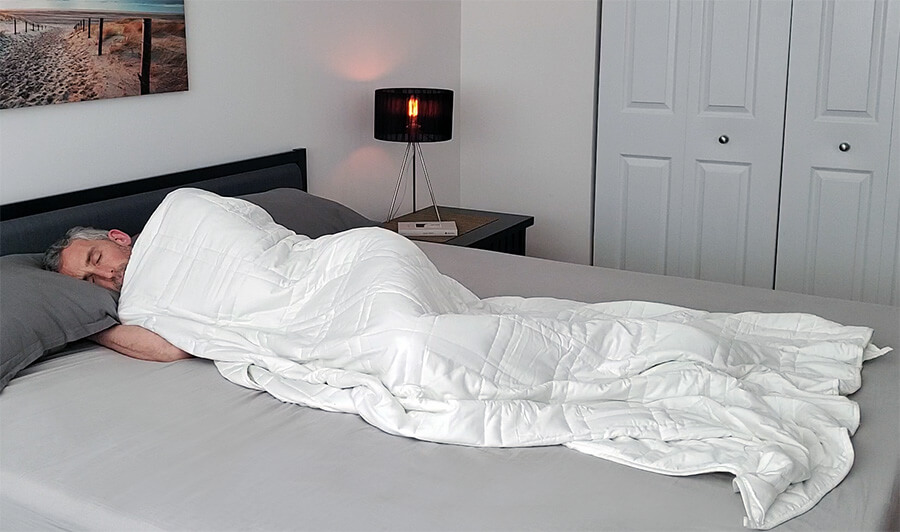
In the photo above, I’m using the Baloo weighted blanket insert without the duvet cover. You can see how it has double stitched pockets to keep the glass microbeads securely in place.
If you like the idea of feeling snug in bed – think even snugger than usual – then a weighted blanket might be the answer. They’ve been gaining in popularity in recent years due to the way they’re designed to create deep pressure touch stimulation.
This ‘hug effect’ is thought to increase serotonin production in the brain, potentially helping with relaxation and maybe even sleep if you need a little extra reassurance to drift off.
I’ve tried various weighted blankets ranging from 15 lb to 25 lb in the last five years, both in the US and the UK. While some companies offer sizes for children, I’ll be focusing on weighted blankets for adults in this article because, well, I’m an adult (most of the time).
If you have any questions about choosing a weighted blanket in general, you might also like to read my tips for choosing a weighted blanket.
Please note that all the photos in this article are my own, so you can see how the weighted blankets look and contour to the same person’s body. They were the exact ones I used, but the companies may make changes to the design in the future.
Contents
Overview of the weighted blankets
Baloo
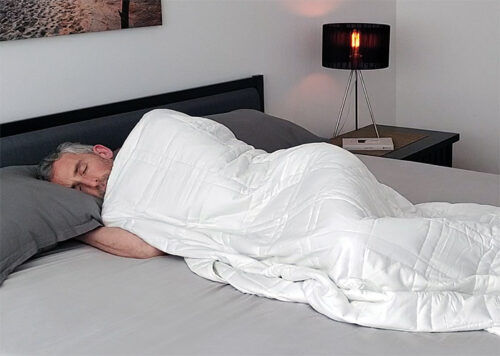
Price: $$$
The Baloo is my top choice if you’d like a comfortable, stylish, and robust weighted blanket. The white insert is beautiful and soft enough to use on its own, while an optional French flax linen covers adds a touch of rustic style. The pockets are double stitched to keep the glass microbeads in place, giving it even weight distribution and ensuring it will last the test of time. The company has an eco-friendly ethos, using sustainably sourced materials. Just keep in mind that it’s one of the more expensive brands.
Bearaby Napper
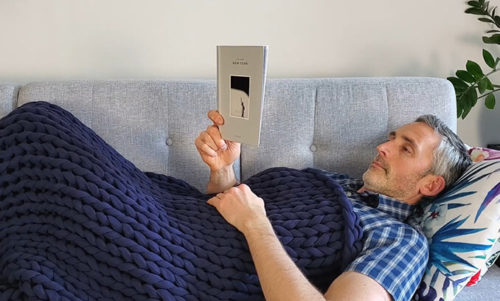
Price: $$$
The Bearaby Cotton Napper is my top pick for hot sleepers as it’s the most breathable weighted blanket I’ve tried. The weight is created by a weave of 100% organic cotton instead of pockets with microbeads and filler, so there are air holes that allow your body heat to escape. It looks great too, both in the living room and bedroom. Like the Baloo, the company uses sustainably sourced materials. One downside is that although it can be machine washed and dried, drying can take two cycles or a long time to air dry.
Gravity Blanket
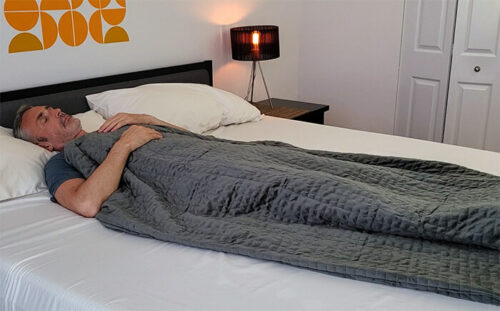
Price: $$$
The Gravity blanket is a cozy weighted blanket, with ample padding and a plush microfleece cover. The internal pockets and stitching are robust, ensuring the microbeads are safely tucked away inside. It’s the only weighted blanket I’ve seen that has zips on three sides to attach the cover, making it quicker and less fiddly than the usual 8-12 loops and ties. If you’re a hot sleeper, but like the look of the Gravity Blanket, there’s also a cooling version with a more breathable cover.
Luxome
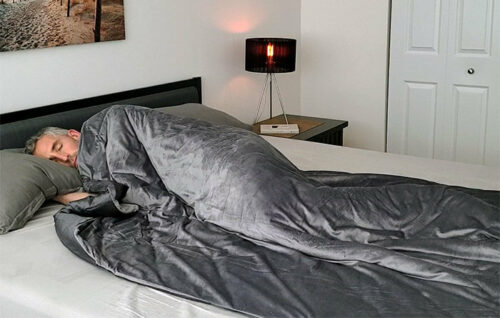
Price: $$$
The Luxome looks elegant, and has a different way to choose the weight. Instead of choosing based on 10% of your body size, you simply select a small, med, large, or extra large to match your body or bed size. There’s a wide range of cover styles to choose from, including some with sensory nodes that tactile people will enjoy. It’s a warm blanket though, with slightly fiddly ties to attach the cover.
Layla
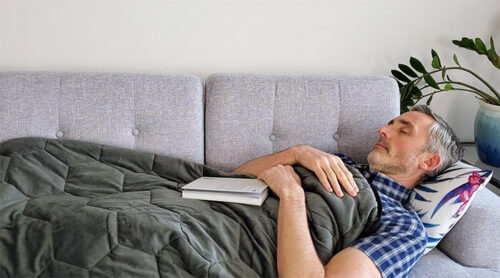
Price: $$
If you’d like a warm one-piece weighted blanket, the Layla is one I recommend. The whole blanket can be machine washed and tumble dried, making it quicker to clean than those with covers. It has a stylish hexagonal pocket design, with strong stitching to secure the glass microbeads. It’s only available in three weights and sizes, and only in green and black, so it won’t be right for everyone. Layla has a straightforward returns policy, so it’s a good choice if you’d like to try one for the first time.
Quility
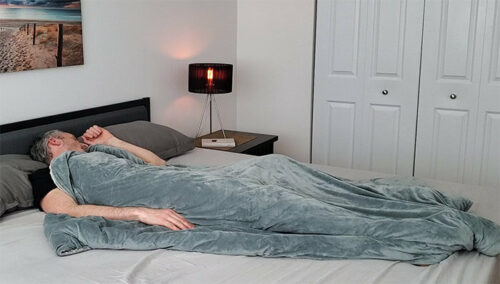
Price: $$
The Quility weighted blanket is a good option for cold sleepers who are shopping on a budget. It feels snug in cold weather, and is considerably less expensive than the premium brands. They have a wide range of sizes, weights, and covers to choose from too. It doesn’t look as elegant as the Baloo, Bearaby, or Gravity, but holds its own compared to other low-budget options such as the YNM (below).
YNM
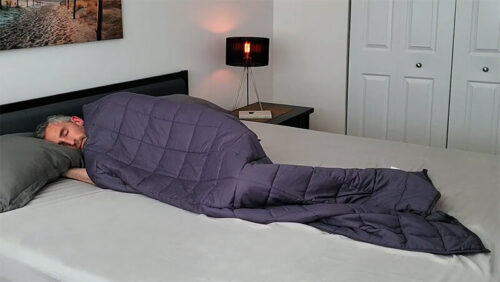
Price: $$
The YNM is a lower-cost weighted blanket with a basic insert that can be jazzed up with multiple duvet cover options. Unusually for weighted blankets, the internal section is available in different colors and patterns too. If you do want a cover, there are plenty of materials, patterns and colors to choose from. It may not look as stylish or feel as soft as the previous weighted blankets, but it’s robust and will still do the job of contouring to your body with its weight.
Cosi Home
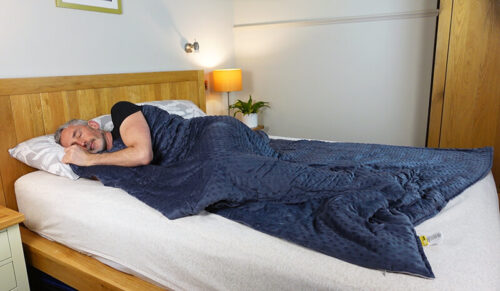
Price: $$
The Cosi Home is an affordable weighted blanket that’s currently only available in the UK (all the others are available in the US and Canada, but only some in the UK). It has a plush minky cover that creates a warm and snug feel, with sensory dots on one side for an additional calming touch. It only comes in one large size and has less weight per square foot than most brands, which some might find more comfortable.
Comparison tables
Table 1: Ratings
In table 1 below, I’ve rated the weighted blankets in four key areas. Please keep in mind that these are quite subjective scores, based on the experience of my partner and I. You may have a different opinion if you try any of the weighted blankets.
For comfort, I took into account how soft both the weighted insert and cover feel, how heavy it felt relative to the dimensions, and whether it felt too warm in average weather when used on top of a medium tog duvet.
For temperature regulation, the score is based on how hot (rather than cozy) we felt when using the weighted blankets all night.
The weight distribution is based on a combination of how uniform the weight feels across the entire blanket, and how we perceived the weight per square foot to feel.
The durability is based on how neat and strong the stitching looked, how secure the loops, ties and zips were attached, and how strong the fabric appeared. I’ve had each blanket for over a month, so I kept an eye out for loose stitching, escaped beads, and worn fabric.
The first five blue links take you the company websites, and the last three to Amazon.
| Brand | Comfort | Temperature Regulation | Weight Distribution | Durability |
|---|---|---|---|---|
| Baloo | 9 | 8 | 9 | 9 |
| Bearaby | 8 | 9 | 8 | 8 |
| Gravity | 7 | 6 | 7 | 7 |
| Luxome | 7 | 7 | 8 | 8 |
| Layla | 7 | 6 | 7 | 7 |
| Quility | 6 | 5 | 7 | 7 |
| YNM | 6 | 6 | 6 | 6 |
| Cosi Home | 6 | 5 | 6 | 6 |
Table 2: Weight options and price range
In table 2 below, you can see the range of weights each blanket is available in, and the price range.
The companies may change the prices in the future. This is just a snapshot taken at the time of my last update (January 26, 2024) to give you an idea of the range of prices you might expect for weighted blankets.
| Brand | Weight range (lb) | Price range (USD) |
|---|---|---|
| Baloo | 9 – 25 | $149-249 (insert) $99-$189 (cover) |
| Bearaby | 6 – 25 | $199 to $279 |
| Gravity | 15 – 35 | $250-$300 |
| Luxome | 8 – 25 | $155-$230 |
| Layla | 15 – 25 | $189-$239 |
| Quility | 5 – 30 | $50-$140 |
| YNM | 5 – 30 | $35-$150 (insert) $30-$80 (cover) |
| Cosi Home | 15 | £79.99 (UK only) |
Table 3: Style, care, and materials
In table 3 below, I’ve described the style of the weighted blankets in one of three ways: one piece that never have a cover, those that come with a cover included, and those that have the cover as an additional extra.
You can also see if they are machine washable or if you can only wash the cover. As for the materials, I’ve listed the main materials that create the weight, the padding, the shell, and the duvet cover.
| Brand | Style | Machine washable Cover & Insert? | Main Materials |
|---|---|---|---|
| Baloo | Insert and optional cover | Yes | Glass microbeads Cotton |
| Bearaby | One piece | Yes | 100% Cotton |
| Gravity | Insert and cover included | Cover only | Glass microbeads Cotton Polyester |
| Luxome | Insert and cover (Integrated option) | Yes | Glass microbeads Cotton Polyester Minky Bamboo lyocell |
| Layla | One piece | Yes | Glass microbeads Cotton Polyester |
| Quility | Insert and cover included | Cover only | Glass microbeads Cotton Polyester |
| YNM | Insert and optional cover | Yes | Glass microbeads Cotton Polyester |
| Cosi Home | Insert and cover included | Cover only | Glass microbeads Cotton Polyester |
The weighted blankets in detail
1. Baloo
The best weighted blanket for adults overall

Key points
- Materials: Glass microbead fill, 100% cotton fabric.
- Care: Machine washable cover and insert.
- Sizes: Mini 9 lb (40″ x 60″), throw 12 lb (42″ x 72″), full/queen 15 lb or 20 lb (60″ x 80″), king/cal king 25 lb (80″ x 87″).
- Price: From $149 to $249, depending on size and color. $99 to $189 extra for the optional cover.
- Trial period: 30 days.
- Warranty: Lifetime craftsmanship warranty.
The Baloo weighted blanket was the first one that really impressed me with the attention to detail that had gone into the design and materials.
It’s currently my top pick for adults because it looks stylish, it’s made with soft cotton, feels breathable, is robustly constructed, hugs your body well, and is conveniently machine washable. Other than the high price, it ticks all the right boxes.
While many weighted blankets contain a lot of polyester, both the exterior and fill of the internal section of the Baloo are 100% cotton. In the photo above, for example, I’m only using the internal section.
The use of high-quality cotton rather than artificial filler makes it second only to the Bearaby (below) in terms of breathability. It won’t keep you cool (none of them will) but it won’t feel as warm as those with a polyester insert and and minky cover.
Another sign of the excellent craftsmanship is that the pockets holding the glass microbeads to create the weight are double-stitched to improve durability. And the even weight distribution due to the small pocket size means it conforms well to your body in all sleep positions. My own Baloo is still going strong after four years, without a single microbead escaping in that time.
The insert of most weighted blankets I’ve tried are made with more basic fabric, but the cotton used for the Baloo’s inner blanket also feels soft and smooth. So that core inner blanket is elegant and comfortable enough to use on its own. But you can also accessorize it with the French flax linen cover to change the aesthetics and make cleaning it easier on your washing machine and dryer.
My main criticism, however, is that the optional cover adds quite a lot of cost to an already pricey weighted blanket. For example, if you get a queen size for $199 and the linen cover for $149, the total cost is $348.
On balance, the Baloo is a beautiful, soft and breathable weighted blanket that conforms well to your body, providing the hug effect that’s needed for it to help you relax. Unless you’re on a tight budget, it’s one I recommend adding to your shortlist.
2. Bearaby Cotton Napper
The best weighted blanket for hot sleepers, with a weave that lets body heat escape
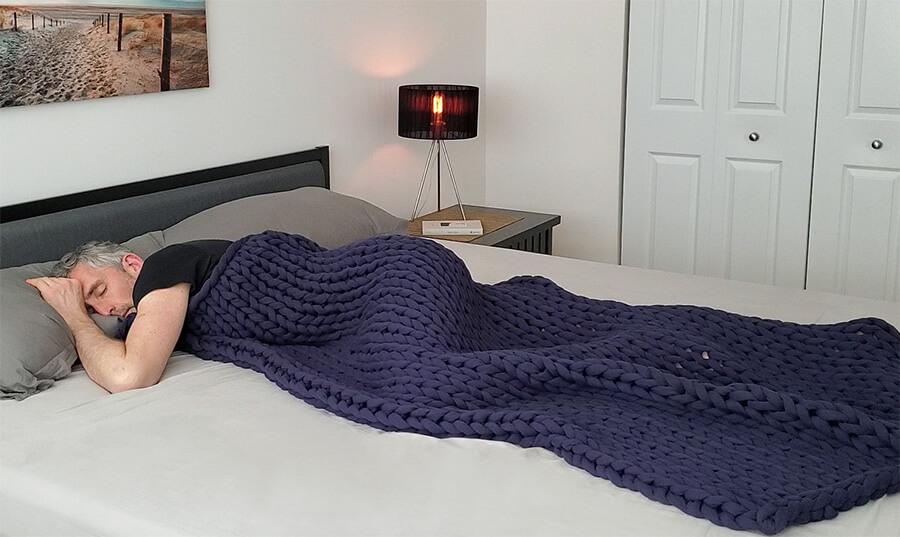
Key points
- Materials: 100% organic cotton.
- Care: Machine washable. Tumble dry low or air dry flat.
- Sizes: 10 lb (40″ x 60″), 15 lb (45″ x 72″), 20 lb (48″ x 72″), 25 lb (48″ x 72″) for adults. 6 lb and 8 lb kid sizes available.
- Price: From $199 to $279 for the adult sizes.
- Trial period: 30 days.
- Warranty: No extended warranty.
The Bearaby Cotton Napper is an outlier in the world of weighted blankets, and one that gives hot sleepers an opportunity to try a weighted blanket without feeling too warm in the middle of the night.
Rather than being filled with microbeads, it’s uniquely hand-knitted with chunky cotton. The 100% organic cotton weave creates natural ventilation, with air holes throughout the entire length and width of the blanket. In a test I did to find the most breathable weighted blanket, the Bearaby Cotton Napper was the winner.
The interlinking weave design also looks modern and stylish, making it a weighted blanket I’m happy to use both in the bedroom and living room.
Although the chunky knit design doesn’t feel as smooth to run your hand across as those with a flat cover, the cotton is soft enough that it feels natural to use it as bedding. The weave is flexible though, so it falls over your body nicely to provide the hug effect through deep pressure stimulation.
The Bearaby company appears to have a strong focus on sustainability; the Cotton Napper is OEKO-TEX® STANDARD 100, Organic Content Standard (OCS) and Fairtrade International certified.
One downside is that cleaning it can be time consuming. It’s good that it’s machine washable, but because it’s a one-piece weighted blanket without a cover, you have to wash the entire thing. While that’s easy enough, drying it takes at least two low cycles or a long time to air dry outside of summer months.
Another point to consider is that like the Baloo, the Bearaby Cotton Napper is at the pricier end of the spectrum of weighted blankets.
Overall, the Bearaby Cotton Napper is the most breathable weighted blanket I’ve tried in the last five years, and is a great choice for adults who tend to sleep hot. You might also like it if you value sustainability or prefer the stylish weave over the more common microbead design.
3. Gravity blanket
The best weighted blanket for cold sleepers, with a convenient zip system to attach the cover
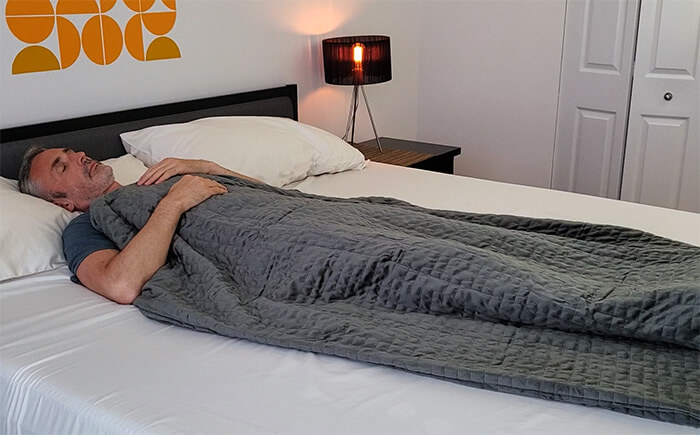
Key points
- Materials: Glass microbeads, cotton and polyester. Micro-plush cover.
- Care: Machine washable cover. Inner section is hand wash only.
- Sizes: Single 15 lb (72″ x 48″), Single 20 lb (72″ x 48″), queen/king 35 lb (90″ x 90″).
- Price: Single $250, queen/king $300.
- Trial period: 30 days.
- Warranty: No extended warranty.
Gravity brought weighted blankets to the fore with their 2017 Kickstarter campaign, arguably starting the ensuing craze. Since then, they’ve evolved their designs, with a clever and unique cover attachment system that particularly impressed me.
I’ve tried four versions of the Gravity Blanket in the past: the original microfleece, the cooling cover, the queen/king size, and the latest upgraded zipper design.
Even though I’m a naturally hot sleeper, I could appreciate how snug and cozy the microfleece cover felt in the winter. It’s warm to use in cold weather, and the cover has a plush feel that looks like it belongs on your bed when it’s freezing outside. I also like the stylish grid pattern of the cover, which gives it a touch of style.
The inner weighted section combines a cotton exterior with polyester filling and glass microbeads, enclosed in six-inch pockets. While the stitching isn’t double-layered like the Baloo, it is strong and has a robust feel.
If you’ve ever tried to remove and reattach the cover of a larger size weighted blanket, you’ll know it can be time consuming and fiddly to deal with all the loops and ties. And if you don’t know the ‘turn it inside out’ trick, you can end up repeating the process when you’ve reattached it the wrong way!
So one point I loved about the Gravity Blanket is that they created a new system with zips to attach the cover on three sides. Not only is this much quicker than tying 12 knots, but it makes it easier to get it right the first time around.
The main downside is that only the cover is machine washable – the inner section is restricted to spot cleaning. And like the Baloo and Bearaby, it’s not a budget weighted blanket.
On balance, the microplush Gravity Blanket is a good choice if you’d like a warm weighted blanket with a cover that’s easier to remove than most brands. They also have a cooling version with a more lightweight cover, but it’s still not as breathable as the Bearaby or Baloo.
4. Luxome
With a comfortable weight per square foot, choose based on the blanket dimensions rather than a percentage of your body weight
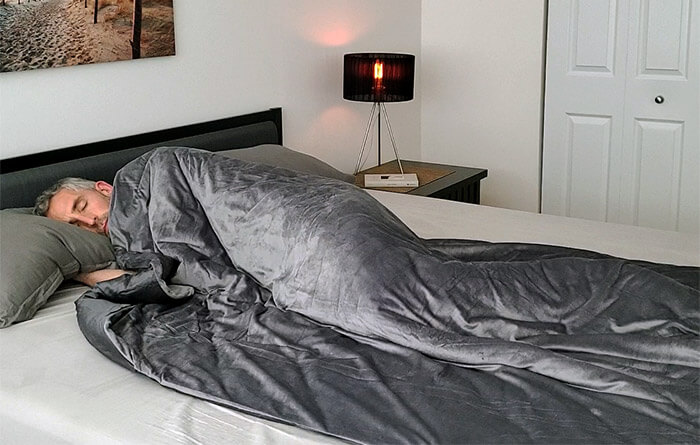
Key points
- Materials: Glass microbeads, cotton, polyester, minky, bamboo lyocell.
- Care: Machine washable cover and inner section.
- Sizes: Small 8 lb (42″ x 56″), medium 15 lb (54″ x 72″), large 18 lb (60″ x 80″), extra large 25 lb (90″ x 80″).
- Price: $155 to $230, depending on size and cover combination.
- Trial period: 30 days.
- Warranty: No extended warranty.
Luxome was the first company I noticed that produced weighted blankets based solely on the bed dimensions rather than a percentage of your body weight. They say their blankets have an average weight per square foot that ”nearly everyone agreed on” during extensive testing.
In the photo above, I’m using the large 18 lb version, which measures 60″ x 80″ and Luxome recommends for most adults. It’s noticeably lighter per square foot compared to many others I’ve tried, such as the 20 lb Bearaby at 45″ x 72″. However, I quite liked the weight, finding it comfortable without putting too much pressure on areas like my toes when lying on my back.
The inner weighted section contains glass microbeads inside six-inch square pockets. It doesn’t have double stitching, but the stitching is robust enough to keep the beads contained inside.
There are several covers to choose from, including double-sided ones. Mine has soft minky on one side and bamboo lyocell on the reverse, which feels cooler on your skin. As well as feeling soft, the cover has a modern look and neat finish. Conveniently, both the inner blanket and the cover are machine washable.
There’s also an integrated cover version, which is a good option if you don’t want to faff around with the loops and ties when you need to wash it.
The main downside is that the inner section material and filler are quite thick, which affects breathability. So this is one that’s best suited to cold sleepers rather than those who sleep warm or who live in hot climates.
Overall, the Luxome weighted blanket strikes a good balance between style and function. It’s one to consider if you’re uncertain about weight choice, would like to share your weighted blanket with a partner, or prefer the optics of covering a larger bed with one blanket instead of a single on just one side.
5. Layla
A stylish one-piece weighted blanket that’s conveniently machine washable
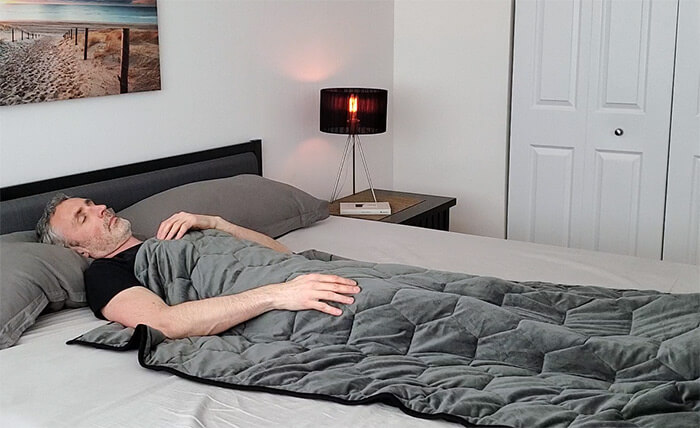
Key points
- Materials: Glass microbead fill. Cotton and polyester minky cover.
- Care: Machine wash and dry.
- Sizes: 15 lbs (48″ x 72″), 20 lbs (60″ x 80″), 25 lbs (80″ x 87″).
- Price: $189 to $239, with regular sale price of $89 to $139.
- Trial period: 30 nights.
- Warranty: Five years.
Like the Bearaby Napper and the integrated cover Luxome versions, the Layla weighted blanket is one piece without a cover. This is ideal for those who prefer to avoid the hassle of detaching and re-attaching an external cover. Instead, you can just pop the entire blanket in the washing machine and dryer.
The hexagonal pocket design and dark green and black exterior gives it a modern look. This is the only color option, however, so it may clash with some bedrooms color schemes.
The weight is created using glass microbeads, and the stitching quality is top-notch, making it a durable weighted blanket. Each pocket contains plenty of fiberfill, which gives it some soft padding and keeps the beads evenly spread. It conforms well to your body, creating the necessary deep touch pressure stimulation for relaxation.
With a plush minky top and a smooth 300-thread count cotton reverse side, the blanket feels luxuriously soft.
The minky exterior and thick fiberfill do mean this is quite a warm weighted blanket though. I didn’t find it quite as warm as the Gravity Blanket, Luxome, or Quility, but it’s definitely not as breathable as the Baloo or Bearaby.
Another point to consider is the limited choice of three weights and dimensions. This might be an issue if you’re looking for a specific weight, but might suit those who prefer to choose based on the bed size rather than their own weight, similar to the Luxome.
Overall, the Layla is a comfortable and modern-looking weighted blanket that’s conveniently machine washable and dryer friendly. It’s just a shame there aren’t more color options as I can’t fault the overall quality.
6. Quility
The best low-cost weighted blankets for adults who like warm bedding
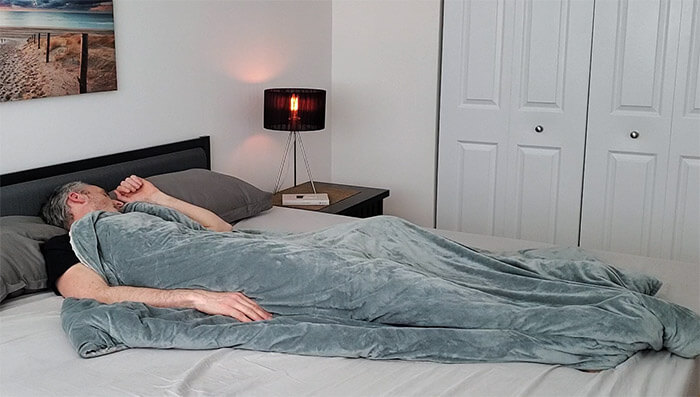
Key points
- Materials: Glass microbead fill. Cotton shell. Polyester padding and duvet cover.
- Care: Machine washable cover. Hand wash or dry clean the inner section.
- Sizes: 14 options, from 5 lb (36″ x 48″) up to 30 lb (86″ x 92″). The 60″ x 80″ blanket is available in 12 lb, 15 lb, 20 lb, or 25 lb.
- Price: $50 to around $140, depending on size and cover color.
- Trial period: 30 days.
- Warranty: No extended warranty.
The Quility weighted blanket is a good choice if you’d like a reasonably priced weighted blanket that provides warmth and snugness along with the hug effect.
Its seven layer composition, paired with a soft minky cover, makes it ideal for chillier nights or those who naturally tend to feel cold in bed.
The inner weighted section houses glass microbeads within six inch square pockets to create a comforting, body-hugging weight. The stitching appears to be robust, with no rogue beads escaping from mine in the four years I’ve had it.
The internal section has a cotton exterior shell, but it doesn’t feel as soft as the Baloo, so I’d recommend getting a cover. The insert isn’t machine washable either, so it’s much more practical to use a cover rather than hand washing or dry cleaning the weighted blanket.
The one I’m using in the photo above is a dual-sided polyester minky cover. It feels very soft, and is fluffier than the Gravity Blanket or Luxome. While one side is relatively flat, the other is covered in sensory nodes. It’s fun to run your hand over the nodes while you’re relaxing, and has a strangely calming effect. It’s like a giant fabric fidget toy!
The Quility weighted blanket is available in a more extensive range of sizes and weights than the luxury brands. Several sizes are available in different weights too, increasing the chances of finding the right match for both bed and personal weight preference.
I think the price is reasonable, especially compared to the Baloo, Bearaby, or Gravity. Many sizes cost less than half the price of the equivalent sizes those companies offer.
For cooler sleepers shopping on a budget, the Quility is one to consider, especially if you like the idea of the sensory nodes. It may not look as stylish as the weighted blankets I covered above and the washing restriction is a downside. But the value for money and cozy feel definitely help make up for that.
7. YNM
An affordable weighted blanket with a wide range of sizes and covers
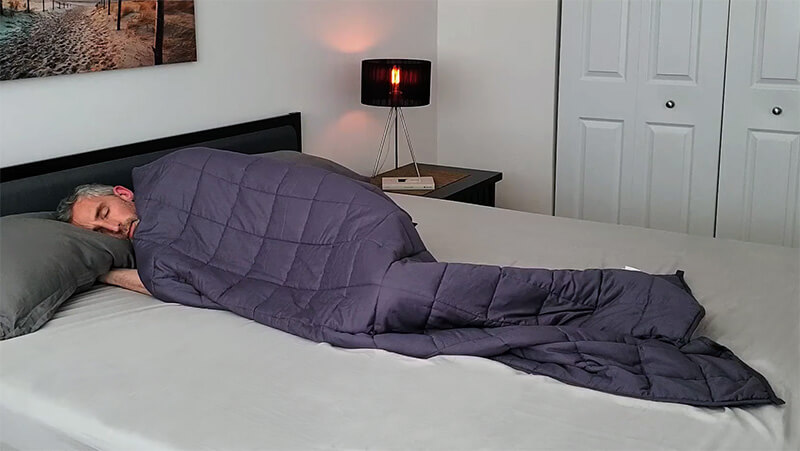
Key points
- Materials: Glass microbead fill. Cotton shell. Polyester padding and duvet cover.
- Care: Machine washable cover and insert.
- Sizes: 16 options, from 5 lb up to 30 lb. The 60″ x 80″ is available in 15 lb, 17 lb, 20 lb, and 25 lb.
- Price: $35 to $150 for the insert, depending on the size and color. $30 to $80 for the optional cover.
- Trial period: 30 days.
- Warranty: No extended warranty.
I bought the YNM weighted blanket out of curiosity to see what the trade-off in quality might be with one of the cheapest weighted blankets I could find.
My experience was that the YNM does what it’s meant to do – provide sufficient and evenly spread weight across the whole body to give you the feeling of deep pressure stimulation. However, the look and texture of the materials were more basic than all the previous weighted blankets in this article.
The exterior shell of the inner YNM weighted blanket is made of quite coarse cotton, similar to the Quility. It just didn’t feel as soft and pleasant to run my hands over or have in contact with my skin.
On the plus side, the pockets measure just 4.7″ x 4.7″. This small size helps distribute the glass microbeads, and therefore the weight, evenly. To its credit, the stitching has held up, showing no signs of wear or loose beads.
Where YNM does excel is in its range. I haven’t seen any other company offer such a wide variety of weights, dimensions, internal colors, and optional covers. It’s uncommon to see different colors and patterns for the inner blanket too, setting it apart from brands that only give you options to customize the cover (if that).
Around the house, the bare YNM won’t impress aesthetically due to the cotton’s texture and basic design. But with a cover, or your own bedding over the top, you can find a way to make it fit it.
As for how breathable it is, I’d put it in the middle of the range. Hot sleepers can definitely find more breathable weighted blankets, but cold sleepers will probably find it’s enough on top of other bedding to boost the snug feel of their bed.
Conveniently, you can machine wash the inner section as well as the cover, which is one point in its favor if you want to try a weighted blanket without increasing the cost by adding a cover.
On balance, the YNM is a practical introduction to weighted blankets without a hefty price tag. It gets the weight part right, but if you’re on the hunt for a premium feel, pretty aesthetics, or breathability, there are more refined options out there.
8. Cosi Home
A warm and affordable weighted blanket (UK only)
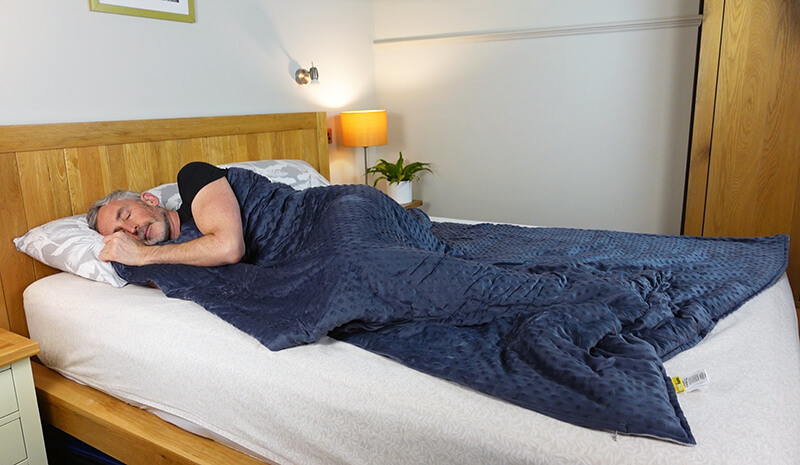
Key points
- Materials: Glass microbead fill. Polyester and cotton layers. Minky cover.
- Care: Machine washable cover. Hand wash or dry clean the inner section.
- Sizes: Only one adult size in the UK: 6.8 kg (203 cm x 152 cm).
- Price: £79.99, currently on sale for £59.99.
- Trial period: 30 days.
- Warranty: No extended warranty.
I got all seven of the weighted blankets I’ve discussed so far while in the United States. I bought the Cosi Home while in the United Kingdom as I wanted to repeat my YNM experiment with a low-cost weighted blanket there.
Just so you know from the outset, Cosi Home only make their weighted blanket in one standard adult size. It’s large enough to just cover my king size bed without hanging over the sides. So I imagine it’s meant for sharing or for those who want to cover the whole bed with a lighter weight per square foot than you typically find in single sizes.
To create the weight, glass microbeads are contained in very small 4″ x 4″ pockets. This impressed me as most others have much larger pockets. It means the beads stay very evenly spread and it contours uniformly to your body across the whole blanket.
On the downside, the external cotton of the insert is quite coarse, so I wouldn’t recommend omitting the cover unless you replace it with your own bedding.
The duvet cover itself is double-sided minky, with a flat profile on one side and sensory nodes on the other. It has a very similar look and tactile feel to the Quility cover. The padded pockets and minky cover do mean it traps your body heat, meaning some hot sleepers will find it uncomfortable.
The loops and ties are well designed, with enough space in the loop to quickly thread the tie when you need to re-attach the cover. Only the cover can be machine washed, so it’s important the loops and ties are relatively easy to do up.
This was one of the lightest per square foot weighted blankets I’ve tried, and I was pleasantly surprised by how comfortable it was. I could still feel enough weight for the relaxing effect of the usual deep pressure stimulation, but without it feeling too heavy at any point.
I hope it will be available in more than one size in the future. But for now, if you’re looking for an affordable weighted blanket for a larger bed in the UK, the Cosi Home weighted blanket might be one to have on your radar.
Closing thoughts
Thanks for taking the time to read this article, and I hope you found a weighted blanket here that appeals to you. Remember to check other reviews too as people sometimes have different opinions about individual weighted blankets.
Three websites with reviews I thought were good because they have some unique insights and also use their own photos include Wirecutter, Sleepopolis, and Sleep Foundation.
As this was a long article, here’s the contents again in case you’d like to re-read any of the sections:

